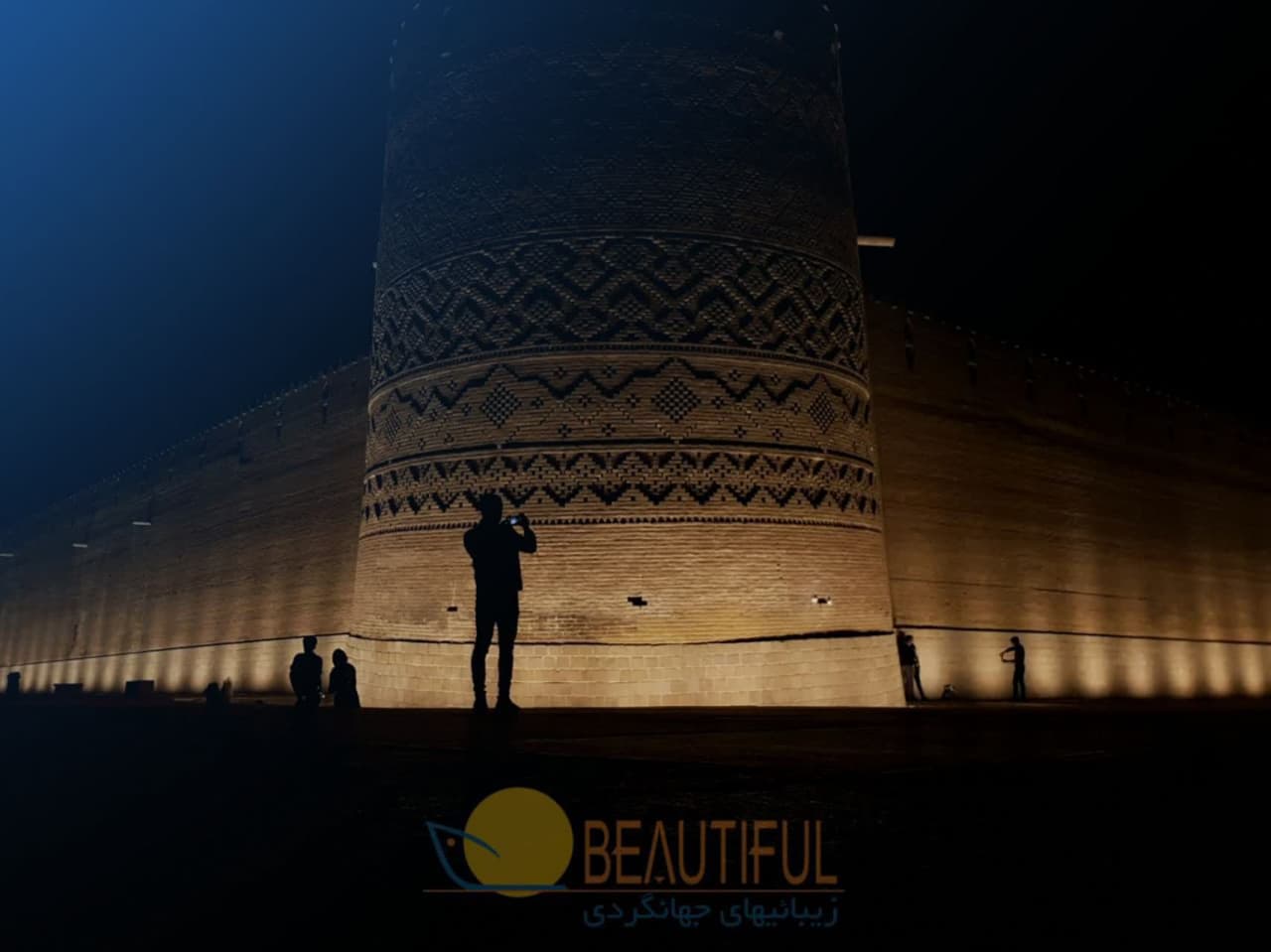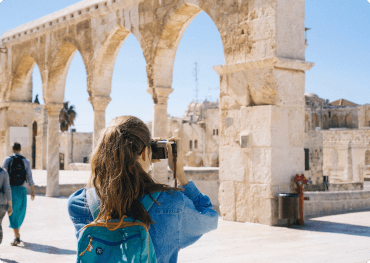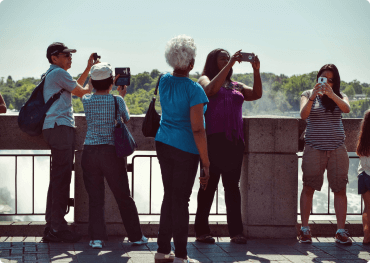
CU-104
Package Details
Day 1: Flight from your home country to Tehran capital of IRAN We prepare ourselves for a fabulous trip to Great Persia. Arrival to Tehran, after custom formality, meet and assist at airport and transfer to the Hotel.
O/N: Tehran
Day 2: Tehran - Kerman After breakfast,
visiting Tehran: Golestan Palace, Carpet museums. Evening transfer to domestic airport and flight to Kerman O/N: Kerman The Golestan Palace is the former royal Qajar complex in Iran's capital city, Tehran. The oldest of the historic monuments in Tehran, and of world heritage status, the Golestan Palace belongs to a group of royal buildings that were once enclosed within the mud-thatched walls of Tehran’s Historic Arg (citadel). It is a masterpiece of beautiful garden and buildings consist of collection of Iranian crafts and European presents from 18th and 19th century. Golestan Palace Complex consists of 17 structures including palaces, museums, and halls. Almost all of this complex was built during the 200 years ruling of Qajarian kings. These palaces were used for many different occasions such as coronation and other important celebrations. It also consists of three main archives as the royal photographic archive collection 'Album khane', the royal library of manuscripts 'Ketabkhane Nosakhe khati' and the archive of documents 'Markaze asnad'.
Carpet Museum of Iran exhibits a variety of Persian carpets from all over Iran, dating from the 16th century to the present. The museum's exhibition hall occupies 3,400 square meters (10,200 ft²) and its library contains 7,000 books. The museum was designed by the last Queen of Iran, Farah Diba Pahlavi. The perforated structure around the museum's exterior is designed both to resemble a carpet loom, and to cast shade on the exterior walls, reducing the impact of the hot summer sun on the interior temperature.
Day 3: Kerman After breakfast, visit to Kerman: Jame Mosque and trip to Rayen around Kerman (106 km) for visiting Rayen Citadel. Then returns to Kerman on the way visiting Bagh-e Shahzadeh& Shahnemat-Ollah e Vali after visiting Mahan continuo to Kerman visiting Gangalikhan Complex O/N: Kerman Mozaffari Mosque next to the Jameh Mosque of Kerman or enthusiastic (martyrs) and enclosed in Mozaffari market and the market is eager Step and Shariati Street and Square in the city of Kerman is located. Including the mosque has four porches with lofty courtyard entrance porch and yard Mubariz al- Din Muhammad Muhammad Muzaffar dynasty during the reign of the Msjddr Muzaffarids has been built according to the inscription on the original date 750 AH listed but later extensions and repairs the mosque has a large veranda at the time of the restoration Tile and Tile columns and Lchkyhay lawyer Molk Mosque and construction yard in the North in the recent period can be named. Sir Agha Mohammad Khan Qajar in the east of the shoot guns were destroyed, but later was restored and rebuilt. Tile mosaic altar is the most valuable eastern entrance of the mosque.
Rhine historical and tourist city in the province and in the mountains of thousands. The city center of the Rhine part of the functions of Kerman city is located in southeastern Kerman. Rhine town of Kerman province is in good weather. Raeini Rhine name was in the past. Raeini one of the great generals and brave Artaxerxes II, the Sassanid king. The city is located in the East-West highway and was considered as an important destination. Rhein- old and ancient civilization at the time of the Sassanids by the West to the East is conveniently located in the highway and one of the trade centers were valuable commodities as well as texture fabrics that were exported even to remote areas such as Egypt. This area used to be one of the centers of the defense industry, such as swords and guns were also. Author of The Geography of Kerman minister, has described the Rhine: Fsyh garden, meadow exquisite creamed with Salsabil brother, whose air by Ferdowsi. In good weather, such as Janet Almava, in peace and without like and unique space.
The Shah Nematollah Vali Shrine is a historical complex, located in Mahan, Iran, which contains the mausoleum of Shah Nematollah Vali, the renowned Iranian mystic and poet. Shah Nematollah Vali died in 1431 aged over 100. In 1436 a shrine was erected in his honor and became a pilgrimage site; with the attention of successive rulers contributing various additions over the centuries.
Shazdeh Garden meaning Prince’s Garden is a historical Persian garden located near (6 km away from) Mahan in Kerman province, Iran. The garden is 5.5 hectares with a rectangular shape and a wall around it. It consists of an entrance structure and gate at the lower end and a two-floor residential structure at the upper end. The distance between these two is ornamented with water fountains that are engined by the natural incline of the land. The garden is a fine example of Persian gardens that take advantage of suitable natural climate. A garden was built originally for Mohammad Hasan Khan Qajar Sardari Iravani ca. 1850 on this site, and was entirely remodeled and extended ca. 1870 by Abdolhamid Mirza Naserodolleh during the eleven years of his governorship in the Qajar dynasty. The current visible structure dates almost entirely to this second period, and is formally related to similar gardens designed by NaseroDolleh in Tehran. The construction was left unfinished, due to the death of Abdolhamid Mirza in the early 1890s.
Ganjali khan set in the old center of the city of Kerman, in Kerman is located next to a large market. Ganjalykhan that famous ruler Shah Abbas is from the year 1005 to 1034 AH Kerman lot of domination and monuments built in the villages of the area tried. Including public buildings that remained famous rulers, set Ganjali khan in the city of Kerman and i Zinedine interest (inn Ganjali khan) on the way Yazd - Kerman, Kerman Howz-e Khan on the road - Mashhad and some canals have been in Kerman. Share of income and canals collection of Astan Quds Razavi buildings in campaigns. This data Agha Mohammad Khan has seen irreparable damage. Ganjali khan area of 11,000 square meters and a building complex elements are: the 1005 AH, the AH 1005, AH 1020 bathroom on the south side, the north side Mint, on the east side of the school and inn 1021 AH 1007 AH, on the west side of the water reservoir in 1021 AH. In the field, which is Ganjalykhan markets coppersmith market and forms part of the main classes. Set Architecture "Astadsltan Mohammad Yazdi architect" and its founder Ganjalykhan, the ruler of Kerman in the years 1005 to 1029 AH have been. Four mosques have four, three of them left the field and the most beautiful mosque in the eastern side of the house is a museum of decorative arts is considered.The architectural style of this building Isfahani style is. Mosque: The building is located in the northeastern right Ganj Ali Khan Kerman Ganj Ali Khan is part of a series about the year 1007 AH. By the Ganj Ali Khan - appointed ruler Shah Abbas Sfvy- made and it seems that a large prayer room inn has been set or an adjacent school. Mosque, small and consists of porch with dimensions of 5 × 25/5 meters and the entrance porch. Facade of the porch, and on the cover of its simple, geometric designs drawn on plaster. And on top of the wooden porch floor is stone, stone inscription is installed with the following words: "Thank heaven the government of Shah Abbas Shah Ganj Ali Khan Dlsh of the world tour in support of the mosque valve ferocious nature of obedience". Bath: The entrance to the bathroom Ganjalykhan , which is part of the recently refurbished Safavid paintings, inscriptions poem in line Nstlyq the carved marble that lines the rest of the year, according to become Abjad indicate "not show anyone in the world such bathroom "(1020 AH)
Day 4: Kerman - Yazd Early morning will continue our trip to Yazd (364 km). Upon arrival, visiting Tower of a Silence (The old Zoroastrian Tomb) after visiting transfer to hotel and check in. O/N: Yazd Cellar Zoroastrians , called the Tower of Silence Tower also known as off. The crypt at 15 kilometers southeast of Yazd Safaieh around the region and on a low-lying sedimentary mountain called Mount crypt is located. The function of this tower was to bury the corpses. In the distant past corpses to the top of the tower meant to be bird feed. Later Myrykhthand bones in a pit. This was done to prevent soil contamination.
Day 5: Yazd After breakfast, city sightseeing visiting Zoroastrian fire temple, Yazd Jame Mosque, Amir Chakhmaq Complex, Bagh-e Doulat Abad, Alexander's prison, Tomb of the 12 Imams. O/N: Yazd Yazd fire whereabouts of the Zoroastrian sacred fire in the city of Yazd and Temple Zoroastrians residing in the city. The main building temples on height of about 21 meters off the ground and in the large yard trees evergreen cypress and pine covered, is located. Figure Forouhar and stone capitals that gives it a special beauty blue pond in front of the building. The temples of properties Altar of the water. The Hall's main building and a wall of stone capitals flowering gems work of artists from Isfahan. This rock artists in Isfahan shaved and then to Yazd have. Tile journalist Forouhar on the entrance, a tile Yazdi artists and architecture of this building of architecture Corp fire temples was persuaded impact. Fire inside the fire burns more than 1,500 years remains bright. This fire is the fire Frvz·hay Carian temple in LARESTAN that Aghda Yazd was brought and kept clear there was nearly 700 years and then in 522 of Aghda in Ardakan Ardakan, Yazd were also nearly 300 years, and in year, 852 ducks were taken to the city. First, in a neighborhood called " Khalaf Ali Khan " a great priest in the house called " priest Adhargushasb shooter " was held in the year 1313 after the construction of the temple was brought into it.
The Jāmeh Mosque of Yazd is the grand, congregational mosque (Jāmeh) of Yazd city, within the Yazd Province of Iran. The mosque is depicted on the obverse of the Iranian 200 rials banknote. The 12th-century mosque is still in use today. It was first built under Ala'oddoleh Garshasb of the Al-e Bouyeh dynasty. The mosque was largely rebuilt between 1324 and 1365, and is one of the outstanding 14th century buildings of Iran. According to the historians, the mosque was constructed in the site of the Sassanid fire temple and Ala'oddoleh Garshasb commenced building the charming mosque. The previous mosque was constructed by order of Ala'oddoleh Kalanjar in 6th century A.H., however the main construction of the present building was done by order of "Seyyed Rokn Al-din Mohammad QAZI".
Amir Chakhmaq Maidan Square in the city of Yazd is. Yazd Amir Chakhmaq of the market , relying , a mosque and two cistern dating back to the Timurid period is. Relying Amir Flint in 1330 and the mosque, Amir Flint in 1341 in the national index Iran were registered. Amyrchqmaq field, one of the most remarkable collections of historical and tourism is the city of Yazd. Amyrjlalaldyn Chqmaq , captains and rulers of the Timurid Shahrukh in solar 8th century when the ruling was Yazd, a set of lean , square, public baths , caravanserais , monasteries , Qnatkhanh and cold water and in so doing promote the build up of Yazd Fatima Khatun, wife, helped him. In 1330 Hijri relying Amir flint and flint Emir Mosque in 1341 number 383 and number 247 on the national index were registered independent. The buildings and other accession as Amir Chakhmaq collection also reached number 2416 to the National Register
Dolatabad garden from the gardens of the old city of Yazd in Iran and the rows Fin Garden in Kashan and Shazdeh Garden in Kerman is.Windward Windward adobe building the tallest tower with a height of 33/8 meters known in the world. The garden on 23/12/1346 in row No. 774 national monuments are located, and also one of the Persian Gardens registered in the World Heritage Site by UNESCO is. Dolat Abad Garden in Yazd in late Afsharieh and in 1160. AH by Mohammad Taghi Khan, known as (Great Khan) that he was Yazd Srslslh Khans dynasty was established. The late Mohammad Taqi Khan's first aqueduct during construction and 65 Kylvmtrra water from Mehriz to Yazd Dolat Abad Garden's current location and then rule sets (Daralhkvmh) founded their own. The garden has an area of about 70/000 square meters, including buildings, ponds and waterfront, a lot of space between them in the gardens with trees, pomegranates and grapes and ... Baglhay abundance adorn their environment
Alexander prison or Zyayyh school is a school with about eight centuries old, in fact, that in the neighborhood Fhadan the city of Yazd in the vicinity of the tomb of the twelve Imams actually been produced. The built in 631 AD by the famous mystic Zia Hussain Razi was built in 705 AD and was completed by his sons Majd Ali Hassan and Shafaruddin.Parts of the building can be a hole with a diameter of about 2 meters in the middle of the school yard which has a depth of about 5 meters leads to the basement, dome of the monument to the height of 18 meters and has Gchbryhay and decorating beauty with golden and blue color that much of it has been undermined.The building is raised on stories dating from making it to the attack of Alexander the Macedonian to Iran than that of the building that was later repurposed been used as a prison and has been used as a school.
Monument twelve of the monuments of the Seljuks in the neighborhood Fhadan city of Yazd in central Iran. Brick dome mausoleum is one of the most important monuments of Seljuk art. This Qph (Dome) is the oldest building in Yazd, according argument and historical Sndyyt is only by birth. Twelve individual Dome of the year 429 AH neighborhood near religious site Fhadan and the oldest building in Yazd in terms of the style and color of Kufic inscriptions important and special role of the journalist and expert on the topic of Islamic architecture. Mr. Arthur Upham Pope several times experienced great scholar and Iranian Studies of the building in Iran has learned the art of sketch books. Eric Shrvydr the map and design work has been published in the book as saying that work here make. Colored inscription on the east side Gvahast plaster walls on the dome of the order of two brothers named Abu Jacob and Abvmsvd was set. It is unclear what name the Twelve Imams from different eras. What is certain, according to the inscription on its base by Abu Masoud Beheshti and Abu Ala al-Dawla the government of Colonel James Isaac, the son of biennials that have been made.
Day 6: Yazd- Shiraz After breakfast, trip to Shiraz (438 km), on the way visiting Pasargad (the history complex about 550 BC) O/N: Shiraz Pasargadae World Heritage collection is a set of ancient structures Brjaymandh from the Achaemenid the city of Pasargadae in Fars Province lies. This total includes buildings such as Tomb of Cyrus the Great , Pasargadae mosque , declared the king's garden , the palace gates , bridges, levee House , House suite , two pavilions , waterfront, garden cress, Tomb of Cambyses , defensive structures Tel bed , inn Mozaffari , sacred ground and Bolaghi Gorge is. This set the fifth set is registered in the World Heritage List in Iran at a meeting of UNESCO in July of 1383 in China was held due to many factors hundred per cent on the World Heritage List was registered. In 529 BC, Cyrus the tribes of the Scythians in Central Asia (North East of Iran) attacked and are at war with massagetae was killed. He was buried in Pasargadae.
Day 7: Shiraz - Persepolis – Shiraz After breakfast trip to Marvdasht area near Shiraz and visiting Persepolis (the big history Complex about 550 BC.) And Naghsh-e Rostam. Afternoon return to Shiraz Visiting Tomb of Hafez and Saadi. O/N: Shiraz Persepolis the name of one of the ancient cities of Iran that joined over the years, the capital 's stately and ceremonial monarchy at the time of the Achaemenid Empire was. In this ancient city called Persepolis palace that during the reign of Darius , Xerxes and Artaxerxes was built and was built for about 200 years. On the first day of the New Year , many groups from different countries representing Satrapyha or governments gathered in Persepolis with diverse took offerings and gifts were presented to the king. Persepolis in 518 BCE as the new capital of the Achaemenid the gamers began. Founder of Persepolis, Darius was, of course, after his son Xerxes and his grandson Artaxerxes I to extend this series to expand it added. Many existing knowledge about the history and culture of the Achaemenid stone inscriptions and Flznvshthhayy is available for the palaces and on the walls and the tablet is engraved. Sumner has estimated that the plain of Persepolis which contains 39 residential camp was in the Achaemenid period 43, 600 people had. Historians believe that Alexander the Macedonian commander Greek in 330 BC, invaded Iran and burned Persepolis and probably a large part of the books, Achaemenid art and culture destroyed by it. However, the ruins of this place is still up and archeology of its ruins signs of fire and rush to acknowledge it. This place since 1979, one of Iran's record on the UNESCO World Heritage is. Persepolis in the northern city near Shiraz , south of Fars province (northeast of Shiraz ) is replaced. At a distance of six and a half kilometers from Persepolis, Naqsh-e Rustam is located.
Naqsh-e Rustam name of the ancient collection Zangiabad village located in the northern city of Shiraz in Fars province of Iran , which is 6 kilometers from Persepolis is located. Yadmanhayy the archaeological site of the Elamite , Achaemenid and Sassanid in its place and has around 1200 BC to 625 AD was the focus of attention because the tomb four kings Achaemenid, Sassanian reliefs of a number of major events, building the Kaaba of Zoroaster and Vyranshdhay relief from the Elamite era in this place and in the Sassanid era, Naqsh-e Rustam area of religious and national importance have been. In the past, this place was Dogonbadan Segonbad or among the people of the region were caught by the names of the mountain, the mountain was also called Nfsht pool or mountains after the Iranians and possibly the name of Naqsh-e Rustam between Rostam , the hero of Shahnameh and communicate the Sassanid kings were Sngngarhhay It was to this place.The oldest role in Naqsh-e Rustam is the Elamite period and the king and queen of the gods and goddesses were portrayed, but later in the Sassanid era, Bahram II parts of it wiped and his role and his courtiers erected in its place. Kaaba of Zoroaster and Brjmannd in the Mhvthast stone building that was built during the Achaemenid period is likely to be unclear and its application is based on three corners of the building has two inscriptions of Shapur I and Kartir written that historically are of great value. Four Tomb dungeon in the bosom of the Mountain of Mercy have been dug that belonged to Darius the Great , Xerxes , Artaxerxes I , and Darius II that all of them have the same properties.Ardashir the first one who in this area, Sngngarhay shaved and Tajgyryash scene of Ahura Mazda recorded. He also Tajgzaryshan Sassanid kings scenes or descriptions of battles and Aftkhartshan on the breast of the mountain. That Artaxerxes and his son Shapur II Nqshbrjsthhayy counterparts in the Achaemenid reliefs in Naqsh-e Rustam shaved, probably in imitation of the past have been the political and cultural sequences
The Tomb of Hafez and its associated memorial hall, the Hāfezieh, are two memorial structures erected in the northern edge of Shiraz, Iran, in memory of the celebrated Persian poet Hafez. The open pavilion structures are situated in the Musalla Gardens on the north bank of a seasonal river and house the marble tomb of Hafez. The present buildings, built in 1935 and designed by the French architect and archaeologist André Godard, are at the site of previous structures, the best-known of which was built in 1773. The tomb, its gardens, and the surrounding memorials to other great figures are a focus of tourism in Shiraz
The Tomb of Saadi is a tomb and mausoleum dedicated to the Persian poet Saadi in the Iranian city of Shiraz. Saadi was buried at the end of his life at a Khanqah at the current location. In the 13th century a tomb built for Saadi by Shams al-Din Juvayni, the vizir of Abaqa Khan. In the 17th century, this tomb was destroyed. During the reign of Karim Khan was built a mausoleum of two floors of brick and plaster, flanked by two rooms. The current building was built between 1950 and 1952 to a design by the architect Mohsen Foroughi and is inspired by the Chehel Sotoun with a fusion of old and new architectural elements. Around the tomb on the walls are seven verses of Saadi’s poems.
Day 8: Shiraz - Isfahan After breakfast, trip from Shiraz to Isfahan (483 km).Upon arrival to Isfahan check in hotel and then Visiting old bridges (Si-o se pol (33 arches) and Pol-e Khajoo) O/N: Isfahan Khaju Bridge is a bridge in the province of Isfahan, Iran, which has been described as the finest in the province. It was built by the Persian Safavid king, Shah Abbas II around 1650, on the foundations of an older bridge. Serving as both a bridge, and a dam (or a weir), it links the Khaju quarter on the north bank with the Zoroastrian quarter across the Zayandeh River. Although architecturally functioning as a bridge and a weir, it also served a primary function as a buildingand a place for public meetings. This structure was originally decorated with artistic tilework and paintings, and served as a teahouse.
Allāhverdi Khan Bridge, popularly known as Si-o-seh pol “The bridge of thirty-three spans” is one of the eleven bridges of Isfahan, Iran and the longest bridge on Zayandeh River with the total length of 297.76 metres (976.9 ft). It is highly ranked as being one of the most famous examples of Safavid bridge design. It was constructed by the finance and the inspection of Allahverdi Khan Undiladze chancellor of Shah Abbas I, an ethnic Georgian, it consists of two rows of 33 arches from either sides, left and right. There is a larger base plank at the start of the bridge where the Zayandeh River flows under it, supporting a tea house which nowadays is abandoned due to the shortage of water and the river drought.
Day 9: Isfahan After breakfast, city sightseeing Naghshe jahan square include: Allighapoo Palace, Imam Mosque, Sheikh lotfolah Mosque, Old Bazaar. Chehel soton Palace (forty pillars palace). After diner visiting Zorkhane (Power House) the local and traditional sport in Iran O/N: Isfahan Naqsh-e Jahan Square, known as Imam Square, formerly known as Shah Square, is a square situated at the center of Isfahan city, Iran. Constructed between 1598 and 1629, it is now an important historical site, and one of UNESCO's World Heritage Sites. It is 160 metres (520 ft) wide by 560 metres (1,840 ft) long (an area of 89,600 square metres (964,000 sq ft)). The square is surrounded by buildings from the Safavid era. The Shah Mosque is situated on the south side of this square. On the west side is the Ali Qapu Palace. Sheikh Lotf Allah Mosque is situated on the eastern side of this square and at the northern side Keisaria gate opens into the Isfahan Grand Bazaar. Today, Namaaz-e Jom'eh (the Muslim Friday prayer) is held in the Shah Mosque.
The Lotfollah Mosque : The Lotfollah Mosque had a secret entrance that spanned underneath the Maidan, from the Palace on the opposite side of the square. Of the four monuments that dominated the perimeter of the Naqsh-e Jahan square, the Lotfollah Mosque, opposite the palace, was the first to be built. The purpose of this mosque was for it to be a private mosque of the royal court, unlike the Shah mosque|Masjed-e Shah, which was meant for the public. For this reason, the mosque does not have any minarets and is of a smaller size. Indeed, few Westerners at the time of the Safavids even paid any attention to this mosque, and they certainly did not have access to it. It wasn't until centuries later, when the doors were opened to the public, that ordinary people could admire the effort that Shah Abbas had put into making this a sacred place for the ladies of his harem, and the exquisite tile-work, which is far superior to those covering the Shah Mosque.
Ali Qapu is in effect but a pavilion that marks the entrance to the vast royal residential quarter of the Safavid Isfahan which stretched from the Maidan Naqsh-i-Jahan to the Chahar Bagh Boulevard. The name is made of two elements: "Ali", Arabic for exalted, and "Qapu" Turkic for portal or royal threshold. The compound stands for "Exalted Porte". This name was chosen by the Safavids to rival the Ottomans' celebrated name for their court : Bab-i Ali, or the "Sublime Porte"). It was here that the great monarch used to entertain noble visitors, and foreign ambassadors. Shah Abbas, here for the first time celebrated the Nowruz (New Year's Day) of 1006 AH / 1597 A.D. A large and massive rectangular structure, the Ali Qapu is 48 m (157 ft) high and has six floors, fronted with a wide terrace whose ceiling is inlaid and supported by wooden columns.
On the sixth floor, the royal reception and banquets were held. The largest rooms are found on this floor. The stucco decoration of the banquet hall abounds in motif of various vessels and cups. The sixth floor was popularly called (the music room) as it was here that various ensembles performed music and sang songs. From the upper galleries, the Safavid ruler watched polo games, maneuvers and horse-racing below in the Naqsh-i-Jahan square.
The Bazaar of Isfahan is a historical market and one of the oldest and largest bazaars of the Middle East. Although the present structure dates back to the Safavid era, parts of it are more than a thousand years old, dating back to the Seljuq dynasty. It is a vaulted, two kilometer street linking the old city with the new
Chehel Sotoun ( “Forty Columns”) is a pavilion in the middle of a park at the far end of a long pool, in Isfahan, Iran, built by Shah Abbas II to be used for his entertainment and receptions. In this palace, Shah Abbas II and his successors would receive dignitaries and ambassadors, either on the terrace or in one of the stately reception halls
The name, meaning "Forty Columns" in Persian, was inspired by the twenty slender wooden columns supporting the entrance pavilion, which, when reflected in the waters of the fountain, are said to appear to be forty. As with Ali Qapu, the palace contains many frescoes and paintings on ceramic. Many of the ceramic panels have been dispersed and are now in the possession of major museums in the west. They depict specific historical scenes such as the infamous Battle of Chaldiran against the Ottoman Sultan Selim I, the reception of an Uzbek King in 1646, when the palace had just been completed; the welcome extended to the Mughal Emperor, Humayun who took refuge in Iran in 1544; the battle of Taher-Abad in 1510 where the Safavid Shah Ismail I vanquished and killed the Uzbek King. A more recent painting depicts Nader Shah's victory against the Indian Army at Karnal in 1739. There are also less historical, but even more aesthetic compositions in the traditional miniature style which celebrate the joy of life and love. The Chehel Sotoun Palace is among the 9 Iranian Gardens which are collectively registered as one of the Iran’s 17 registered World Heritage Sites under the name of the Persian Garden
Sport builds or ancient sport or sport athletic movements set up sports with toys and Byasbab and customs related to their history and culture within Iran have been prevalent from ancient times. Sports Other Sports Zurkhaneh name of the ancient Persians. Where the ancient sport engaged gymnasium is also a gymnasium in addition to wrestling as sport builds up. World Zurkhaneh rituals record of athletic and heroic efforts and Zurkhaneh Sports Federation Iran in cooperation with the Cultural Heritage, Handicrafts and Tourism Organization were prepared. Zurkhaneh rituals and athletic on 25 Persian date Aban 1389 of 16 November 2010 on the list of Intangible Heritage of UNESCO by Iran was a world record.
Day 10: Isfahan - Tehran After breakfast, check out hotel and visiting Vank Church, Isfahan Jame Mosque, Hasht Behsht Palace. Afternoon drive to Tehran and transfer to International airport. Holy Savior Cathedral is a cathedral located in the New Julfa district of Isfahan, Iran. It is commonly referred to as the Vank (Վանք), which means "monastery" or "convent" in Armenian language. The cathedral was established in 1606, dedicated to the hundreds of thousands of Armenian deportees that were resettled by Shah Abbas I during the Ottoman War of 1603-1618. The varying fortunes and independence of this suburb across the Zayande River and its eclectic mix of European missionaries, mercenaries and travelers can be traced almost chronologically in the cathedral's combination of building styles and contrasts in its external and internal architectural treatment.
The Jāmeh Mosque of Isfahān is the grand, congregational mosque (Jāmeh) of Isfahān city, within Isfahān Province, Iran. The mosque is the result of continual construction, reconstruction, additions and renovations on the site from around 771 to the end of the 20th century. The Grand Bazaar of Isfahan can be found towards the southwest wing of the mosque. It is a UNESCO World Heritage Site since 2012. This is one of the oldest mosques still standing in Iran, and it was built in the four-iwan architectural style, placing four gates face to face. An iwan is a vaulted open room. The qibla iwan on the southern side of the mosque was vaulted with muqarnas during the 13th century. Muqarnas are niche-like cells.
Hasht Behesht, meaning "Eight Paradises" is a Safavid era palace in Isfahan. It was built in 1669 and is today protected by Iran's Cultural Heritage Organization. Of more than forty mansions which existed in Isfahan during the rule of Safavids, this is the only one left today.
Day 11: Departure Tehran Flight to your country.
Details
Pellentesque accumsan magna in augue sagittis, non fringilla eros molestie. Sed feugiat mi nec ex vehicula, nec vestibulum orci semper. Class aptent taciti sociosqu ad litora torquent per conubia nostra, per inceptos himenaeos. Donec tristique commodo fringilla. Duis aliquet varius mauris eget rutrum. Nullam sit amet justo consequat, bibendum orci in, convallis enim. Proin convallis neque viverra finibus cursus. Mauris lacinia lacinia erat in finibus.
Pellentesque accumsan magna in augue sagittis, non fringilla eros molestie. Sed feugiat mi nec ex vehicula, nec vestibulum orci semper. Class aptent taciti sociosqu ad litora torquent per conubia nostra, per inceptos himenaeos. Donec tristique commodo fringilla.
- Specilaized Bilingual Guide
- Private Transport
- Entrance Fees
- Box Lunch,Water,Dinner and Snacks
Pellentesque accumsan magna in augue sagittis, non fringilla eros molestie. Sed feugiat mi nec ex vehicula, nec vestibulum orci semper. Class aptent taciti sociosqu ad litora torquent per conubia nostra, per inceptos himenaeos. Donec tristique commodo fringilla.
- Specilaized Bilingual Guide
- Private Transport
- Entrance Fees
- Box Lunch,Water,Dinner and Snacks
Pellentesque accumsan magna in augue sagittis, non fringilla eros molestie. Sed feugiat mi nec ex vehicula, nec vestibulum orci semper. Class aptent taciti sociosqu ad litora torquent per conubia nostra, per inceptos himenaeos. Donec tristique commodo fringilla.
- Specilaized Bilingual Guide
- Private Transport
- Entrance Fees
- Box Lunch,Water,Dinner and Snacks
Pellentesque accumsan magna in augue sagittis, non fringilla eros molestie. Sed feugiat mi nec ex vehicula, nec vestibulum orci semper. Class aptent taciti sociosqu ad litora torquent per conubia nostra, per inceptos himenaeos. Donec tristique commodo fringilla.
- Specilaized Bilingual Guide
- Private Transport
- Entrance Fees
- Box Lunch,Water,Dinner and Snacks
Pellentesque accumsan magna in augue sagittis, non fringilla eros molestie. Sed feugiat mi nec ex vehicula, nec vestibulum orci semper. Class aptent taciti sociosqu ad litora torquent per conubia nostra, per inceptos himenaeos. Donec tristique commodo fringilla.
- Specilaized Bilingual Guide
- Private Transport
- Entrance Fees
- Box Lunch,Water,Dinner and Snacks






















